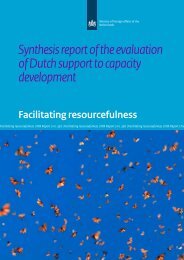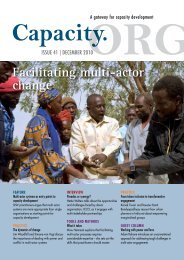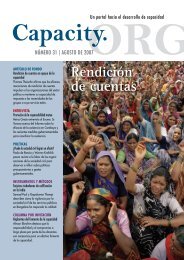Pro-Poor Value Chain Development - Capacity.org
Pro-Poor Value Chain Development - Capacity.org
Pro-Poor Value Chain Development - Capacity.org
You also want an ePaper? Increase the reach of your titles
YUMPU automatically turns print PDFs into web optimized ePapers that Google loves.
24<br />
transactions and production processes that occur before a product is brought to<br />
market. Furthermore, there is need to study how these economic agents interact<br />
with a variety of stakeholders that might influence such relations (for instance<br />
policymakers, researchers and service providers).<br />
The main assumption made in applying value chain thinking within the development<br />
sector is that vulnerable actors in developing countries (such as smallholder farmers<br />
and small and medium-sized enterprises) can be both constrained and enabled by<br />
the broader institutional environment and the interplay of economic relations in<br />
which they operate.<br />
The evolution of value chain thinking is not limited to academic circles alone. Its<br />
growing influence has induced a paradigmatic shift in the practice of development<br />
cooperation, and particularly in the design of interventions targeting poor agricultural<br />
producers. Many rural interventions traditionally focused on strengthening the supply<br />
capacities of smallholders without paying attention to markets. In the worst-case<br />
scenario, the resulting productivity improvements contributed to driving down prices,<br />
leaving farmers even worse off. One of the key lessons learnt from decades of often<br />
disappointing results is that any intervention that seeks to enhance the productivity<br />
of smallholder farmers must ensure that there is demand for the commodities<br />
produced.<br />
The adoption of value chain thinking also led to a shift in the general assumption<br />
within development practice that the economic advancement of one actor inevitably<br />
occurs at the cost of other actors. 2 In a recent article in the Harvard Business Review<br />
Porter referred to this as ‘shared value’ or the economic rationale for companies to<br />
f<strong>org</strong>e synergies between company performance and societal needs.<br />
The fine tuning of value chain principles to foster pro-poor development is<br />
characterised by a number of features:<br />
a. A holistic approach that stresses systemic constraints and opportunities derived<br />
from the configuration of market and extra-market relations (networks);<br />
b. The notion that economic development is achieved through joint action by all<br />
relevant actors;<br />
c. Recognition of the private sector as a key engine of growth and a willingness to<br />
strengthen the action of lead firms, particularly with regard to their linkages with<br />
more vulnerable agents in the value chain;<br />
d. A shift in the ‘centre of gravity’ from the creation of supply capacity to the<br />
creation of market linkages and the establishment of business relationships.<br />
<strong>Pro</strong>-poor value chain development<br />
The core assumption behind ‘pro-poor’ value chain interventions is that vulnerable<br />
upstream agents (such as smallholder farmers) can be ‘pulled’ into specific markets,<br />
and therefore successfully integrated into economic dynamics to which they were<br />
hitherto excluded, or, at best, only participated under very unfavourable conditions.<br />
Practitioners aim to accomplish this through: (i) building and enhancing linkages<br />
between the ‘middle’ of the value chain (processors, traders, exporters and farmers’<br />
<strong>org</strong>anisations) and the market; (ii) strengthening the relationship between the<br />
same ‘middle’ of the value chain and smallholder farmers and, (iii) strengthening<br />
the supply capacity (ability to produce increased volumes of goods or services with<br />
particular attributes) to ensure that these goods and services are produced at a<br />
lower cost and in line with market requirements, increasing overall competiteveness.<br />
A key feature of value chain interventions is thus the recognition that one of the<br />
main causes of poverty traps is inefficient, or missing, linkages between producers<br />
2 BOAM recognised that for value chain development to occur, all actors involved needed to become<br />
successful. This meant that BOAM did not ‘take sides’ by trying to advance smallholder farmers at<br />
the cost of traders and other private sector actors.













